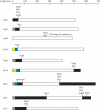Vacuolar hydrolysis and efflux: current knowledge and unanswered questions
- PMID: 30422029
- PMCID: PMC6333459
- DOI: 10.1080/15548627.2018.1545821
Vacuolar hydrolysis and efflux: current knowledge and unanswered questions
Abstract
Hydrolysis within the vacuole in yeast and the lysosome in mammals is required for the degradation and recycling of a multitude of substrates, many of which are delivered to the vacuole/lysosome by autophagy. In humans, defects in lysosomal hydrolysis and efflux can have devastating consequences, and contribute to a class of diseases referred to as lysosomal storage disorders. Despite the importance of these processes, many of the proteins and regulatory mechanisms involved in hydrolysis and efflux are poorly understood. In this review, we describe our current knowledge of the vacuolar/lysosomal degradation and efflux of a vast array of substrates, focusing primarily on what is known in the yeast Saccharomyces cerevisiae. We also highlight many unanswered questions, the answers to which may lead to new advances in the treatment of lysosomal storage disorders. Abbreviations: Ams1: α-mannosidase; Ape1: aminopeptidase I; Ape3: aminopeptidase Y; Ape4: aspartyl aminopeptidase; Atg: autophagy related; Cps1: carboxypeptidase S; CTNS: cystinosin, lysosomal cystine transporter; CTSA: cathepsin A; CTSD: cathepsin D; Cvt: cytoplasm-to-vacuole targeting; Dap2: dipeptidyl aminopeptidase B; GS-bimane: glutathione-S-bimane; GSH: glutathione; LDs: lipid droplets; MVB: multivesicular body; PAS: phagophore assembly site; Pep4: proteinase A; PolyP: polyphosphate; Prb1: proteinase B; Prc1: carboxypeptidase Y; V-ATPase: vacuolar-type proton-translocating ATPase; VTC: vacuolar transporter chaperone.
Keywords: Autophagy; efflux; glutathione; hydrolase; lysosome; polyphosphate; proteolysis; vacuole.
Figures


Similar articles
-
Aspartyl aminopeptidase is imported from the cytoplasm to the vacuole by selective autophagy in Saccharomyces cerevisiae.J Biol Chem. 2011 Apr 15;286(15):13704-13. doi: 10.1074/jbc.M110.173906. Epub 2011 Feb 22. J Biol Chem. 2011. PMID: 21343297 Free PMC article.
-
A newly characterized vacuolar serine carboxypeptidase, Atg42/Ybr139w, is required for normal vacuole function and the terminal steps of autophagy in the yeast Saccharomyces cerevisiae.Mol Biol Cell. 2018 May 1;29(9):1089-1099. doi: 10.1091/mbc.E17-08-0516. Epub 2018 Mar 22. Mol Biol Cell. 2018. PMID: 29514932 Free PMC article.
-
Two distinct pathways for targeting proteins from the cytoplasm to the vacuole/lysosome.J Cell Biol. 1997 Dec 29;139(7):1687-95. doi: 10.1083/jcb.139.7.1687. J Cell Biol. 1997. PMID: 9412464 Free PMC article.
-
Molecular machinery required for autophagy and the cytoplasm to vacuole targeting (Cvt) pathway in S. cerevisiae.Curr Opin Cell Biol. 2002 Aug;14(4):468-75. doi: 10.1016/s0955-0674(02)00343-5. Curr Opin Cell Biol. 2002. PMID: 12383798 Review.
-
Transport of proteins to the yeast vacuole: autophagy, cytoplasm-to-vacuole targeting, and role of the vacuole in degradation.Semin Cell Dev Biol. 2000 Jun;11(3):173-9. doi: 10.1006/scdb.2000.0163. Semin Cell Dev Biol. 2000. PMID: 10906274 Review.
Cited by
-
Dynamic Regulation of the 26S Proteasome: From Synthesis to Degradation.Front Mol Biosci. 2019 Jun 7;6:40. doi: 10.3389/fmolb.2019.00040. eCollection 2019. Front Mol Biosci. 2019. PMID: 31231659 Free PMC article. Review.
-
Vacuolar proteases and autophagy in phytopathogenic fungi: A review.Front Fungal Biol. 2022 Oct 26;3:948477. doi: 10.3389/ffunb.2022.948477. eCollection 2022. Front Fungal Biol. 2022. PMID: 37746183 Free PMC article. Review.
-
Phosphate Restriction Promotes Longevity via Activation of Autophagy and the Multivesicular Body Pathway.Cells. 2021 Nov 13;10(11):3161. doi: 10.3390/cells10113161. Cells. 2021. PMID: 34831384 Free PMC article.
-
VTC4 Polyphosphate Polymerase Knockout Increases Stress Resistance of Saccharomyces cerevisiae Cells.Biology (Basel). 2021 May 30;10(6):487. doi: 10.3390/biology10060487. Biology (Basel). 2021. PMID: 34070801 Free PMC article.
-
Atg45 is an autophagy receptor for glycogen, a non-preferred cargo of bulk autophagy in yeast.iScience. 2024 Apr 26;27(6):109810. doi: 10.1016/j.isci.2024.109810. eCollection 2024 Jun 21. iScience. 2024. PMID: 38832010 Free PMC article.
References
-
- Teichert U, Mechler B, Müller H, et al. Lysosomal (vacuolar) proteinases of yeast are essential catalysts for protein degradation, differentiation, and cell survival. J Biol Chem. 1989. September;264(27):16037–16045. PubMed PMID: 2674123; eng. - PubMed
Publication types
MeSH terms
Substances
Grants and funding
LinkOut - more resources
Full Text Sources
Molecular Biology Databases
Research Materials
Miscellaneous
